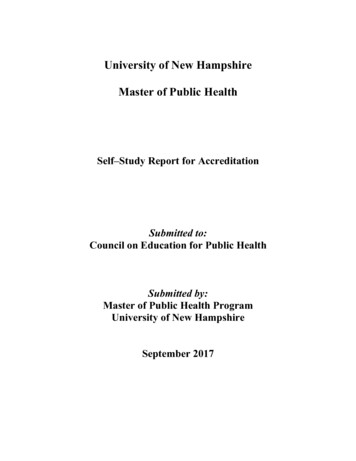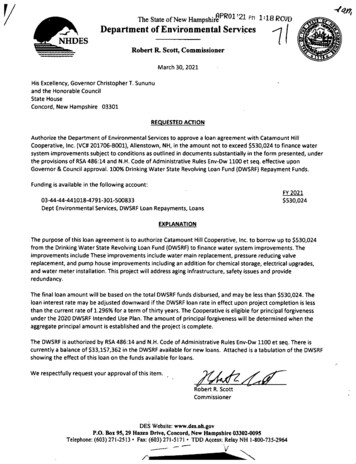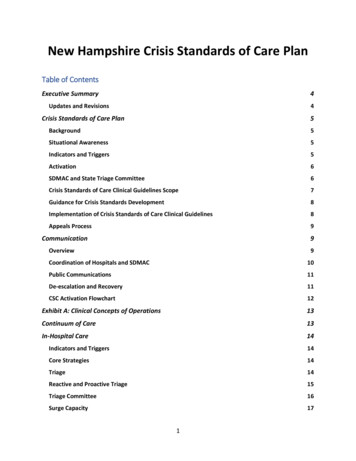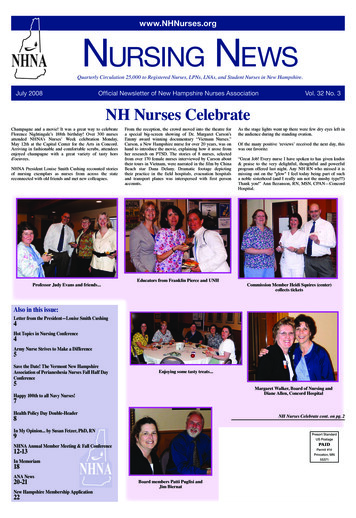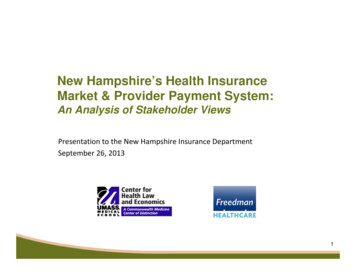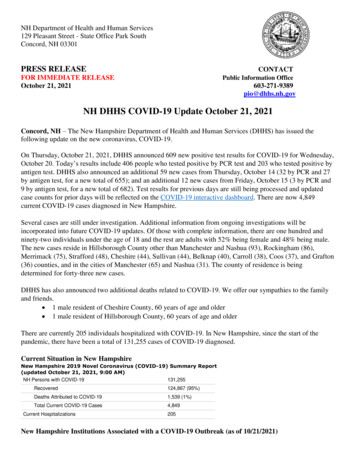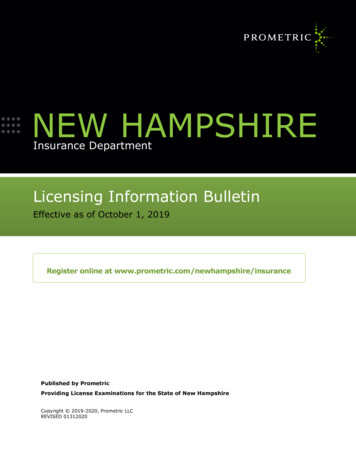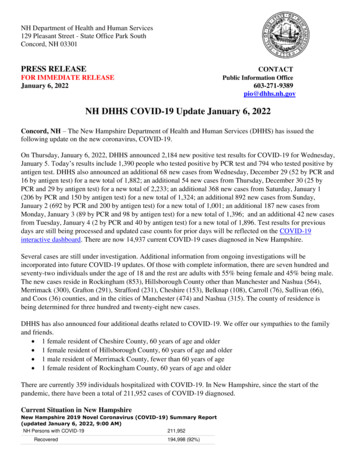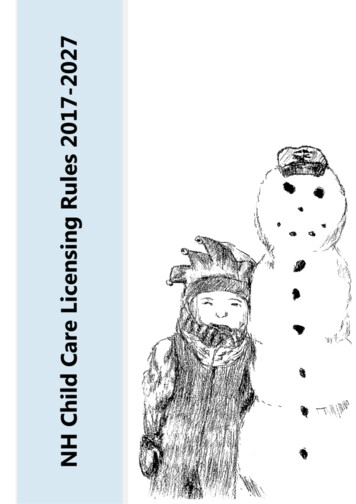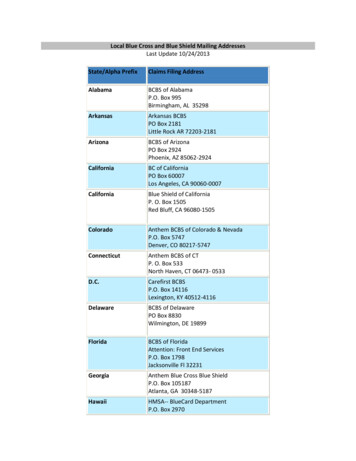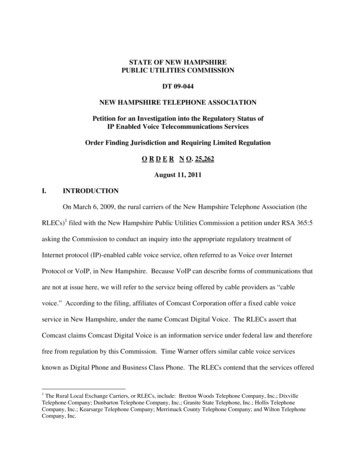
Transcription
STATE OF NEW HAMPSHIREPUBLIC UTILITIES COMMISSIONDT 09-044NEW HAMPSHIRE TELEPHONE ASSOCIATIONPetition for an Investigation into the Regulatory Status ofIP Enabled Voice Telecommunications ServicesOrder Finding Jurisdiction and Requiring Limited RegulationO R D E R N O. 25,262August 11, 2011I.INTRODUCTIONOn March 6, 2009, the rural carriers of the New Hampshire Telephone Association (theRLECs)1 filed with the New Hampshire Public Utilities Commission a petition under RSA 365:5asking the Commission to conduct an inquiry into the appropriate regulatory treatment ofInternet protocol (IP)-enabled cable voice service, often referred to as Voice over InternetProtocol or VoIP, in New Hampshire. Because VoIP can describe forms of communications thatare not at issue here, we will refer to the service being offered by cable providers as “cablevoice.” According to the filing, affiliates of Comcast Corporation offer a fixed cable voiceservice in New Hampshire, under the name Comcast Digital Voice. The RLECs assert thatComcast claims Comcast Digital Voice is an information service under federal law and thereforefree from regulation by this Commission. Time Warner offers similar cable voice servicesknown as Digital Phone and Business Class Phone. The RLECs contend that the services offered1The Rural Local Exchange Carriers, or RLECs, include: Bretton Woods Telephone Company, Inc.; DixvilleTelephone Company; Dunbarton Telephone Company, Inc.; Granite State Telephone, Inc.; Hollis TelephoneCompany, Inc.; Kearsarge Telephone Company; Merrimack County Telephone Company; and Wilton TelephoneCompany, Inc.
-2-DT 09-044by Comcast and Time Warner are not information services subject only to federal regulation, butpublic utility services that should be regulated under RSA 362:2.If the RLECs are correct and these competitive offerings are public utility services, stateregulation under current law would entail minimal regulatory oversight over cable companyaffiliates and their voice service offerings, the same as that exercised over other competitivelocal exchange carriers (CLECs). Such regulation would include registration with theCommission, notice of rates for service offerings, filing of annual reports of sales, number ofcustomers, and infrastructure in New Hampshire as well as updated contact information, andpayment of an annual utility assessment. Certain consumer protection rules would also apply, aswould the obligation to cooperate with other utilities during emergencies to ensure the orderlyrestoration of service. There would be no constraints on pricing or product offerings for suchproviders.This docket considers whether cable voice service in general, and Comcast Digital Voiceand Time Warner’s Digital Phone and Business Class Phone, in particular, constitute conveyanceof a telephone message under RSA 362:2, whether providers of such services are public utilities,and the extent to which federal law preempts New Hampshire law with regard to such services.II.PROCEDURAL HISTORYOn May 6, 2009, the Commission issued an Order of Notice scheduling a prehearingconference and technical session for June 24, 2009, and setting a deadline of June 19, 2009 forintervention requests. On June 11, 2009, the Office of Consumer Advocate (OCA) notified theCommission of its participation on behalf of residential ratepayers, consistent with RSA 363:28.Timely requests to intervene were filed by Comcast Phone of New Hampshire, LLC and itsaffiliates (collectively Comcast); segTEL, Inc. (segTEL); New Hampshire Internet Service
-3-DT 09-044Providers’ Association (NHISPA); Union Telephone Company (Union); Otel Telekom (Otel);TWC Digital Phone LLC (Time Warner or TWC Digital Phone); and New England Cable andTelecommunications Association, Inc. (NECTA).A prehearing conference took place as scheduled on June 24, 2009, during which allpetitions to intervene were granted. Comcast proposed a stay of the proceeding pending adecision from the Federal Communications Commission (FCC) regarding the regulatoryclassification of VoIP. The RLECs noted that ongoing proceedings in Maine and Vermont werenot stayed pending FCC action. The Commission denied the stay, finding that there wereinsufficient assurances that the FCC would rule in the immediate future.On July 1, 2009, Staff and the Parties filed a proposed procedural schedule, which wasapproved by secretarial letter on July 2, 2009. The RLECs notified the Commission onSeptember 25, 2009, that the Parties had been unable to reach agreement regarding a stipulationof facts and would proceed to filing testimony on October 9, 2009. Testimony was filed on thatdate by David J. Kowolenko and Beth Choroser on behalf of Comcast; Valerie Wimer andDouglas Meredith on behalf of the RLECs; and James Medica and Julie Laine on behalf of TimeWarner. Reply testimony was filed on December 4, 2009, by the RLECs, Comcast, and TimeWarner.On December 11, 2009, Comcast filed a letter reporting that the Parties had agreed towaive cross-examination, and requested that the official record be deemed to consist of the prefiled direct and reply testimony, the data requests and responses exchanged among the parties,and the briefs due to be filed in January 2010. By secretarial letter dated December 11, 2009, theCommission canceled the hearing as requested and directed the Parties to file any data requestsand responses they wished to be included in the record prior to the filing of initial briefs. On
-4-DT 09-044January 6, 2010, with the consent of all parties, counsel for the RLECs filed data requests anddata responses received from Parties for filing in the docket record. On January 15, 2010, initialbriefs were filed by the RLECs, Comcast, and Time Warner. Reply briefs were filed on January29, 2010, by the same Parties. On February 2, 2010, Comcast filed a motion for leave to file surreply briefs; which the Commission granted, and on March 5, 2010, sur-reply briefs were filedby Comcast, the RLECs, and Time Warner.III.FACTUAL BACKGROUNDTo understand this case, basic definitions and jurisdictional lines are important. Thefederal Telecommunications Act,47 U.S.C. §§ 151 et seq.2 provides the following definitions:“Telecommunications” - “the transmission, between or among points specified bythe user, of information of the user’s choosing, without change in the form orcontent of the information as sent and received.” 47 U.S.C. § 153 (50).“Telecommunications service” - “the offering of telecommunications for a feedirectly to the public, or to such classes of users as to be effectively availabledirectly to the public, regardless of the facilities used.” 47 U.S.C. § 153 (53).“Information service” - “the offering of a capability for generating, acquiring,transforming, processing, retrieving, utilizing, or making available informationvia telecommunications, and includes electronic publishing, but does not includeany use of any such capability for the management, control, or operation of atelecommunications system or the management of a telecommunications service.”47 U.S.C. § 153 (24).Under the Telecommunications Act, “telecommunications services” are subject to both federaland state regulation; “information services” are not telecommunications services and are exemptfrom state regulation. See, generally, 47 U.S.C. §§ 153, 251, 252, and 253.VoIP is a voice transmission service that can be “fixed” or “nomadic.” Most technologycurrently deployed to transmit voice traffic uses Internet protocol (IP) and IP packets. Nomadic2The Telecommunications Act was revised in October 2010. As a result, certain existing provisions referred toduring the course of this proceeding were renumbered, including the definitions of “telecommunications” [formerly§153(43); now §153(50)]; “telecommunications service” [formerly §153(46); now §153(53)]; and “informationservice” [formerly §153(20); now §153(24)]. The revised references are used in this order.
-5-DT 09-044VoIP service can be enabled from any broadband connection to the public Internet; while it isassociated with a particular account, it is not associated with a particular geographic location. Incontrast, fixed VoIP is routed over the provider’s network, rather than the public Internet. FixedVoIP, in contrast, is enabled from a defined geographic location (e.g. an end-user’s house) andcan be enabled only from that location. The cable voice offerings at issue in this case are fixedVoIP services. In December 2010, the FCC confirmed that it had not yet determined whether toclassify VoIP as a telecommunications or information service. See In the Matter of Preservingthe Open Internet - Broadband Industry Practices, Report and Order FCC 10-201 (Dec. 23,2010) (“Net Neutrality Order”) at ¶ 70 and fn. 345.The FCC and federal courts have found that nomadic VoIP is an interstate service and thatstate regulation is preempted. The FCC has not ruled on the regulatory status of cable voiceservice. Some states have found cable voice to be a regulated utility service while others havefound it to be subject only to federal regulation; many states are awaiting federal guidance.In this case we consider whether Comcast Digital Voice [and TWC Digital Phone andBusiness Class Phone] are public utility services regulated under New Hampshire law. RSA362:2, I defines a public utility to include an entity “owning, operating or managing any plant orequipment or any part of the same for the conveyance of telephone or telegraph messages . . . forthe public.” From the user’s perspective, the VoIP services offered by Comcast and TimeWarner function in a manner similar to that of traditional telephone service, and the essentialconveyance of messages is the same, albeit with the use of different technology at certain pointsin the process.Cable companies typically offer three categories of service to residential and businesscustomers: television programming, broadband Internet connections, and telephone service. See
-6-DT 09-044Prefiled Direct Testimony of Kowolenko and Choroser at 4. Although the provider may promoteand sell bundled packages to retail customers, all three service offerings can be offeredseparately and are delivered independently over a single coaxial cable reaching the customer’shome or workplace. Id. at 18.The cable operator provides telephone-specific hardware to customers subscribing tocable telephone service. This additional hardware, called an “embedded multi-media terminaladapter” or eMTA, includes a standard telephone jack with the same physical and electricalcharacteristics as a telephone jack from a traditional telephone company such as FairPointCommunications or any one of the RLECs. See Kowolenko Response to Staff DR 1-8,introduced as Exhibit VW 1-5, at 99. The customer then plugs in a standard, traditionaltelephone or a telephone wire that is connected to multiple standard telephones. See KowolenkoResponse to Staff DR 1-2, introduced as Exhibit VW 1-5, at 95.When a customer subscribes to multiple cable services, the television signal, Internetconnection, and telephone service are isolated from and do not rely on each other. Each serviceis allocated its own independent portion of bandwidth on the coaxial cable. See KowolenkoResponse to Staff DR 1-3, introduced as Exhibit VW 1-5, at 96.The customer uses a telephone handset which converts voice sound waves into electricalsignals. The eMTA formats these signals into IP packets that can be routed onto the IP networksutilized by Comcast and Time Warner. See Prefiled Direct Testimony of Kowolenko andChoroser at 17. The IP packets travel from (or to) the customer’s location via coaxial cable.The cable voice service provider maintains an IP network over which calls are routed. A cabletelephone call may be transferred to and transmitted over the public switched telephone network
-7-DT 09-044(PSTN)3 where the call recipient is a customer served by a traditional wire line telephone carrier,a wireless carrier, or a cable telephone customer served by a different provider. When a callmoves from the cable provider’s network to the PSTN, it is converted at a Media Gateway fromthe IP packets the cable provider uses into the Time Division Multiplexing (TDM) format usedin the PSTN. See Prefiled Direct Testimony of Kowolenko and Choroser at 20.The customer dials a standard telephone number using a standard telephone handset justas if it were attached to a traditional phone line. See Prefiled Direct Testimony of Valerie Wimerat 5. Local calls use seven digits; long-distance calls may use “1” followed by a three-digit areacode. The called customer picks up the handset to receive a call, using a traditional telephoneline, a cable telephone line, or a cell phone. See Kowolenko response to Staff DR 1-1, introducedas Exhibit VW 1-5, at 94; Cannon Response to Staff DR 1-1, introduced in Exhibit VW 1-5, at118. Cable voice customers may port their existing telephone numbers when they subscribe to acable telephone service, or the provider can assign new phone numbers corresponding to theNXX codes assigned to the geographic region where the customer is located. See, e.g., ComcastBr. at 8 and fn. 34 (VoIP providers are subject to number portability obligations). Thus, in termsof functionality and equipment, cable voice service appears no different from traditionaltelephone service, although it uses different technologies to provide similar functionality. SeePrefiled Direct Testimony of Kowolenko and Choroser at 15.Cable operators often promote telephone service as part of a “bundle” in which thesubscriber also purchases television and broadband Internet. The transmission of cabletelephone calls, however, does not rely on broadband Internet service. See Kowolenko Responseto Staff DR 1-3, introduced as Exhibit VW 1-5, at 96. Unlike calls made over a “nomadic” VoIP3Public switched telephone network (PSTN) is the legacy common carrier network and switching systemconnecting public users throughout the world for the completion of voice calls.
-8-DT 09-044telephone service such as Vonage or Skype, cable voice calls do not require a broadbandconnection to the Internet, are not transmitted over the Internet, and do not compete forbandwidth space on the Internet with e-mail and video traffic. See Cannon Response to Staff DR1-11, introduced as Exhibit VW 1-6, at 121. Indeed, some cable providers emphasize this in theiradvertising, noting that the segregation of voice traffic provides greater reliability. See Petitionof Rural LECs at 3. Furthermore, the cable customer’s telephone number is tied to the particularcoaxial cable drop and/or eMTA provided by the cable company. See Prefiled Direct Testimonyof Kowolenko and Choroser at 17. This means the customer enjoys “plug and play” operationwhen he attaches a traditional telephone handset to the eMTA – and it also means that thecustomer cannot use the cable telephone service when away from the cable drop (for example,the service is not available using a wireless Internet connection at a coffee shop). SeeKowolenko Response to Staff DR 1-11, introduced as Exhibit VW 1-5, at 101.The cable voice services offered by Comcast and Time Warner include voice signals,traditional telephone handsets and interconnection with the PSTN. From a customer’sperspective, there is no difference in the experience of dialing through the IP-enabled cablesystem compared with dialing through a traditional telephone system.IV.POSITIONS OF THE PARTIES AND STAFFA. Rural Carriers of the New Hampshire Telephone Association1. State RegulationThe RLECs’ claim that Comcast and Time Warner are offering cable voice services thatoriginate and terminate in New Hampshire over cable facilities, unfairly competing with theRLECs. The RLECs assert that this competition is unfair because they are subject to the fullregulation of the Commission while competitors, such as Comcast and Time Warner, provide
DT 09-044-9identical services but are not regulated. They argue that this regulatory structure is arbitrary,discriminatory, and without statutory or policy justification. The RLECs state that cable voiceservice constitutes “owning, operating or managing . . . plant or equipment . . . for theconveyance of telephone . . . messages . . . for the public” in accordance with RSA 362:2. TheRLECs reason that to the extent such services include real-time voice communications betweenpoints in New Hampshire, the provision of the service requires franchise authority from theCommission under RSA 374:22 and RSA 374:22-g. The RLECs argue that this Commissionshould determine that cable voice service is regulated telephone service, and that providers suchas Comcast and Time Warner should be required to obtain certification and comply with NewHampshire’s utility statutes and the rules and orders of the Commission.The RLECs add that cable voice service offers transmission of voice information of thecustomer’s choosing between or among points specified by the end user, and that there is nochange in form or content of the voice information sent or received by a cable voice service. TheRLECs claim that the end user experience in making and receiving calls is the same for bothcable voice and for the regulated local exchange service provided by the RLECs. No additionalor different actions are required to place and receive cable voice calls than are required forregulated local exchange calls. The RLECs maintain that while cable voice may differ in thespecific technology used to provide it, the service the customer receives is telephone service.Regardless of whether it is a traditional PSTN call or a cable voice call, the RLECs argue, thereare five primary functional elements of a telephone call: 1) customer premises equipment (e.g.,in the majority of cases, a telephone handset), 2) loop, 3) switching, 4) signaling and 5) transport.The RLECs describe these functional elements as follows:
- 10 -DT 09-0441) Customer premises equipment for residences include, for example, telephone handsetsand modems. Customers purchase and own equipment from any retail outlet or from the serviceprovider. According to the RLECs, the majority of traditional telephone handsets use the sametransmission technology and are used interchangeably with cable voice and regulated RLECservice.2) “Loop” is the term that describes the facilities and equipment located in the field thatprovide the connection between a customer’s location and the associated switching center. Inplace of the twisted pair of copper wires traditionally used by RLECs (or, alternatively, fiber),cable voice service is provided over a hybrid fiber-coaxial loop facility. Both copper loop andcoaxial cable technologies employ connections at intermediate locations between a switchingcenter and the customer. At those intermediate locations, electrical voice signals are convertedinto optical signals that are carried over fiber. Each of these loop technologies connects toswitching and transmission electronics in a centralized location.3) Just as with loop plant, several technologies can be used for switching voice calls.Comcast and Time Warner use IP-based, packet switching “soft switches.” Most telephonecompanies use digital electronic circuit switches, but some are migrating to soft switches. Ineither case, the soft switch or digital circuit switch determines where the call needs to be routedto reach the called party and can also be called a router.4) Most, if not all, interoffice transport is carried on optical fiber, according to theRLECs. While the Internet can be used to provide interoffice transport for voice and data traffic,the carrier has little, if any, control over the quality of the connection and may not be able to givevoice traffic priority over data traffic. The RLECs note that Comcast and Time Warner use theirown private networks, rather than the public Internet, to transmit traffic.
- 11 -DT 09-0445) Signaling consists of instructions that monitor the status of a call, alert the user toincoming calls, transmit routing information and change routing of the call using criteria bothfrom the dialed digits and other information. According to the RLECs, cable voice routing andtraditional Signaling System 7 networking have some of the same characteristics.The RLECs assert that these functional elements are the same, although the manner inwhich the functions are performed at a technical level varies with the particular technology used.Nonetheless, they argue, the overall result is the same: voice calls are originated and terminatedin real time across a distance.The RLECs conclude that cable voice conveys telephone messages as described in RSA362:2 and has all the characteristics of a telecommunications service as this term is defined bythe Telecommunications Act.4 It is a paid service offered directly to the public, and entails voicetransmission among points specified by the user without a change in the form or content of thevoice information as sent and received. The RLECs assert that there is nothing about cablevoice, architecturally, technically, or practically, that distinguishes it from traditional phoneservice, and that cable voice is simply an evolution in technology – voice networks havemigrated from analog to digital and now the voice network is migrating to IP technologies.The RLECs emphasize that authority over cable voice service is not an expansion of theCommission’s traditional jurisdiction. While it is true that the New Hampshire Supreme Courtfound that the Commission does not have authority under RSA 362:2 to regulate industries thatare merely “related” to utility services, the RLECs assert that cable voice should be regulated,not because it is “somehow related” to telephone service but because it is telephone service, nodifferent than the telephone services provided by regulated RLECs, incumbent local exchangecarriers and competitive local exchange carriers (CLECs). The RLECs argue that where a4See 47 U.S.C.§ 151 et seq., generally, and § 153, specifically.
- 12 -DT 09-044service “conveys the telephone message for the benefit of its customers,” the Commission isfully empowered to assert its jurisdiction. According to the RLECs, the Commission’s authorityis defined by the characteristics of the companies and services it regulates, not the technologyemployed to provide those services; the RLECs do not recommend that the Commission expandits powers, but that it exercise the power it has been granted by the legislature.2. Federal PreemptionThe RLECs maintain that Congress has created “a system of dual state and federalregulation over telephone service, grant[ing] to the FCC the authority to regulate ‘interstate andforeign commerce in wire and radio communication,’ while expressly denying ‘jurisdiction withrespect to . . . intrastate communication service . . . .”5 The RLECs contend that the authority toregulate intrastate communication service is expressly reserved to the states. Because, accordingto the RLECs, cable voice service has a discernible intrastate component, state law is notpreempted.The RLECs state that, given the dual-jurisdictional boundaries established by Congress,the FCC historically has applied a geographic “end-to-end” analysis based on the physicalendpoints of a communication to distinguish interstate from intrastate communications forpurposes of establishing and enforcing its jurisdiction. This “end-to-end” analysis poses aproblem, the RLECs reason, when the jurisdictional end-points of a call using nomadic VoIPcannot be determined, as in the Vonage Order,6 where the FCC preempted the MinnesotaCommission from regulating Vonage’s nomadic VoIP service. The RLECs state that the FCCfound that the geographic endpoints of communications using Vonage’s nomadic “DigitalVoice” VoIP service could not be determined with any certainty, thus making it “impossible” to5RLEC Br. at 18, citing Louisiana Pub. Serv. Comm’n v. F.C.C., 476 U.S. 355, 360 (1986).In re Vonage Holdings Corp., WC Docket No. 03-211, Memorandum Opinion & Order, 19 FCC Rcd 22404 (2004)(“Vonage Order”).6
- 13 -DT 09-044know whether a specific communication was an intrastate communication subject to stateregulation, or an interstate communication subject to federal regulation. As a result, the FCCheld that preemption of the Minnesota state regulations was warranted as they were deemed toconflict with “federal rules and policies governing interstate Digital Voice communications.”The RLECs point out that the FCC also asserted that other VoIP services with “basiccharacteristics similar to [Vonage’s] Digital Voice” would be exempt from state regulation. TheRLECs argue, however, that cable voice does not have “basic characteristics similar to[Vonage’s] Digital Voice,” because it requires the end-user to use a geographically specifictelephone number at a fixed location, unlike nomadic VoIP service that does not rely on a fixedlocation. Like the RLECs, both Comcast and Time Warner offer only fixed service to their endusers, so it is possible to identify the locations where a call originates and terminates. TheRLECs observe that this fundamental character distinction was confirmed in the U.S. EighthCircuit Court of Appeals’ review of the Vonage Order. Specifically, the RLECs state, the courtobserved that when VoIP service is “offered as a fixed service rather than a nomadic service, theinterstate and intrastate portions of the service can be more easily distinguished,” holding that theFCC action in Vonage focused exclusively on “nomadic VoIP” service and did not address fixedVoIP services.7 Thus, argue the RLECs, while Comcast and Time Warner would parlay theVonage Order into a federal preemption of all VoIP service, the reach of the Vonage Order isactually far less broad.The RLECs note that, in a post-Vonage proceeding concerning universal service funding,the FCC elaborated on the limits of the preemption decreed in the Vonage Order as follows:[A]n interconnected VoIP provider with the capability to track thejurisdictional confines of customer calls would no longer qualify for thepreemptive effects of our Vonage Order and would be subject to state7RLEC Br. at 20, citing Minn. Pub. Utils. Comm’n v. FCC, 483 F.3d 570 (8th Cir. 2007).
- 14 -DT 09-044regulation. This is because the central rationale justifying preemption setforth in the Vonage Order would no longer be applicable to such aninterconnected VoIP provider.8The RLECs contend that the USF Order unambiguously recognizes that VoIP providers with thecapability to track jurisdictional confines, that is, interstate from intrastate calls, do not qualifyfor Vonage preemption and are therefore subject to traditional state telephone regulation. In theRLECs’ view, it necessarily follows that intrastate cable voice service also lies beyond the reachof the FCC’s power of preemption and, therefore, is subject to state regulation.The RLECs allege that Comcast misreads the Vonage Order to apply to cable voiceservice and argue that the order limits preemption to only those services that are comparable tothe Vonage service. A comparable service, subsequently labeled “interconnected VoIP,” wasdefined in the Vonage Order by the FCC and codified at 47 C.F.R. § 9.3 as “a service that:(1) Enables real-time, two-way voice communications;(2) Requires a broadband connection from the user’s location;(3) Requires Internet protocol-compatible customer premises equipment (CPE); and(4) Permits users generally to receive calls that originate on the public switchedtelephone network and to terminate calls to the public switched telephone network.”The RLECs maintain that the cable voice services provided by Comcast and TimeWarner do not meet all of these criteria. First, their services are based on fixed interconnection,not the nomadic broadband connection that the FCC envisioned, thus falling short of the secondtest. The Vonage Order stated that, “[i]n marked contrast to traditional circuit-switchedtelephony . . . however, it is not relevant where that broadband connection is located or evenwhether it is the same broadband connection every time the subscriber accesses the service.Rather, Vonage’s service is fully portable; customers may use the service anywhere in the world8Universal Service Contribution Methodology, WC Docket No. 06-122, Report and Order and Notice of ProposedRulemaking, 21 FCC Rcd 7518 ¶ 56 (2006) (USF Order).
- 15 -DT 09-044where they can find a broadband connection to the Internet.”9 The RLECs allege that Comcastand Time Warner acknowledge that their cable voice services are not portable to “any”broadband connection, and that the same connection must be used every time a subscriberaccesses the cable voice service. In other words, their cable voice services are fixed, notnomadic such as that provided by Vonage.The RLECs assert that cable voice also fails the third test, use of IP-compatible customerpremises equipment. In the Vonage Order, the FCC observed that:[c]ustomers may choose among several different types of specialized [equipment](1) a Multimedia Terminal Adapter (MTA), which contains a digital signalprocessing unit that performs digital-to-audio and audio-to-digital conversion andhas a standard telephone jack connection; (2) a native Internet Protocol (IP)phone; or (3) a personal computer with a microphone and speakers, and softwareto perform the conversion (softphone).10In contrast, the RLECs argue, Comcast and Time Warner cable voice services require use ofequipment that is provided by Comcast or Time Warner. The customer has no control over thecompany-owned multimedia terminal adapter (eMTA), and the traditional telephone handsetused to originate a call is the only customer equipment required. Furthermore, soft phones andnative IP phones, i.e., handsets that convert voice signals into IP, do not work with theseservices. Therefore, the RLECs assert, the eMTAs provided by Comcast and Time Warner donot meet the
voice." According to the filing, affiliates of Comcast Corporation offer a fixed cable voice service in New Hampshire, under the name Comcast Digital Voice. The RLECs assert that Comcast claims Comcast Digital Voice is an information service under federal law and therefore free from regulation by this Commission.
